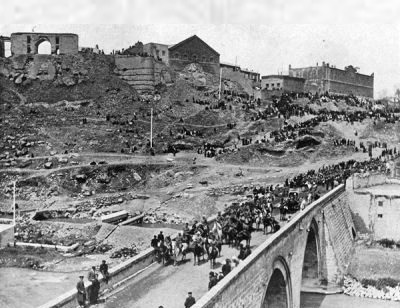
Armenian-Azerbaijani conflict
The Armenian-Azerbaijani conflict entered the history of the 20th century as one of the most tragic conflicts, its consequences had a serious impact on the fate of millions of Azerbaijanis.
This conflict, which started in the late 1980s with Armenia’s open territorial claims to the historical lands of Azerbaijan, provocations on ethnic grounds, and terrorist acts resulted in military aggression against Azerbaijan.
The Armenians in the Soviet Union leadership, the leadership of the Armenian SSR, and the Armenian diaspora abroad took advantage of the weakening of the central government in the late 1980s and began purposeful actions to separate the Nagorno-Karabakh Autonomous Oblast (NKAO) from Azerbaijan SSR, and integrate it to the Armenian SSR.
At the end of 1987, the process of brutal deportation of Azerbaijanis from their historical lands began in the Gafan region of the Armenian SSR. In 1988–1989, Azerbaijanis living in different cities and regions of Armenia faced the same fate. More than 250,000 Azerbaijanis living in Armenia were forcibly expelled from their historical lands, 216 of them were brutally murdered, and 1154 were injured. They were forced to seek refuge in Azerbaijan to save their lives from Armenian violence.
Azerbaijanis lived compactly in the territory of Armenia until 1988. However, unlike the Armenians living in the territory of Nagorno-Karabakh, the Soviet authorities did not give autonomous status to the territories where Azerbaijanis were compactly settled within the Armenian SSR.
The beginning of the conflict
Dueing the years of 1905–1906, 1918–1920, 1948–1953, Azerbaijanis were purposefully displaced and deported from the territory of present-day Armenia. Only in 1948–1953, more than 150 thousand Azerbaijanis were forcibly deported from their historical homes in the territory of the Armenian SSR. At that time, some of them, especially the elderly and babies, died because they could not endure the harsh conditions of relocation, sharp climate change, physical shocks and spiritual suffering.
On February 13, 1988, the first demonstration of Armenians regarding the Karabakh issue was held in the center of NKAO, Khankendi (Stepanakert at that time). From February 16 to March 2, various rallies were organized in NKAO. On February 20, Armenian-born deputies of the NKAO Council of People’s Deputies voted in favor of the proposal to join the Armenian SSR (Azerbaijani and deputies of other nationalities did not participate in the meeting). On February 21, the Central Committee of the Communist Party of the Soviet Union issued a decision “On the events of Nagorno-Karabakh”, and in this document, the decision of the NKAO Council was called an action “instigated by nationalist elements”. Nevertheless, on February 22, near Askaran settlement located on the Khankendi-Aghdam highway, Armenians opened fire on peaceful Azerbaijani demonstrators who protested against the above-mentioned decision of the NKAO Council of People’s Deputies. As a result, two young Azerbaijanis were martyred. At the beginning of March, the “Karabakh” organization, which was aimed to integrate Nagorno-Karabakh to Armenia, started its activities in Yerevan, and the “Krunk” organization started its activities in Khankendi.
On June 14, the Supreme Soviet of the Armenian SSR adopted a decision on the “incorporation” of NKAO into the Armenian SSR. In protest, on June 17, the Supreme Soviet of the Azerbaijan SSR reconfirmed the NKAO as part of the Azerbaijan SSR. On July 18, the Presidium of the Supreme Soviet of the USSR made a decision that it was impossible to change the national-territorial division of the Azerbaijan SSR and the Armenian SSR. With this, the Supreme Soviet of the USSR defended the principle of territorial integrity of the republics, guided by the relevant provision established in the Constitution of the USSR (Article 78).
As the overall state structure of the USSR weakened, the situation in the region worsened. Armed groups and terrorists, mainly sent from Armenia, engaged in disruptive activities in Nagorno-Karabakh. In such conditions, the activity of the Special Administration Committee (January 12 – November 28, 1989) created by the decision of the Presidium of the Supreme Soviet of the USSR failed.
On December 1, 1989, the Supreme Soviet of the Armenian SSR adopted a decision “On the unification of the Armenian SSR and Nagorno-Karabakh”. On January 9, 1990, the Supreme Soviet of the Armenian SSR included the socio-economic development of the NKAO in the 1990 plan of the Armenian SSR. On May 20, 1990, the election of deputies from NKAO to the Supreme Soviet of the Armenian SSR was held.
The decisions of the Supreme Soviet of the Armenian SSR clearly revealed the aggressive nature of Armenia. Territorial claims against Azerbaijan were put forward not only by nationalist groups, but also by the government of Armenia. Armenia wanted to occupy a part of Azerbaijan’s territory at any cost.
As a result of the victory of the Armenian National Movement in the parliamentary elections held in Armenia in May 1990, the extreme nationalist and chauvinist forces that propagated the war in the republic came to power. This accelerated the beginning of the aggressive war. Yerevan focused all its efforts on the creation of unofficial military units and their arming, preferring to solve the problem by force. It is for this reason that Armenia never approached the negotiation process seriously and tried to take advantage of it only for the purpose of creating an image in the international public opinion.
Both on the eve of the war and in the subsequent period, Azerbaijan’s position was fully justified in terms of the USSR Constitution and international legal norms. But at that time, the inactivity of the political elite of Azerbaijan and the absence of a political leader in the republic made the situation even more difficult. During this period, the prominent statesman, a far-sighted personality capable of analyzing the course of events comprehensively, perceive the will and principled stance of the people for the resolution of issues, mobilize the population for a common purpose, the national leader of the Azerbaijani people Heydar Aliyev was in forced resignation. His removal from politics had a direct effect on deepening the conflict which benefitted the Armenians.



